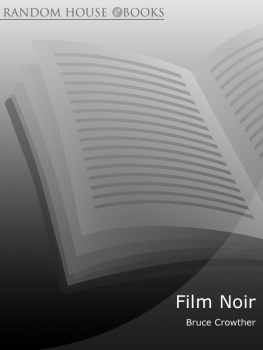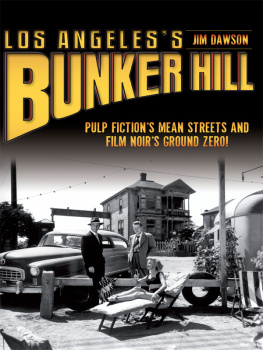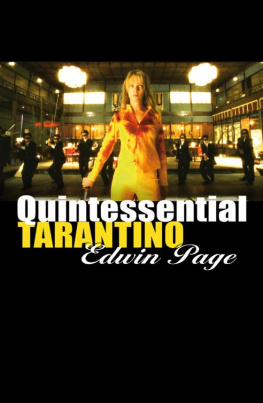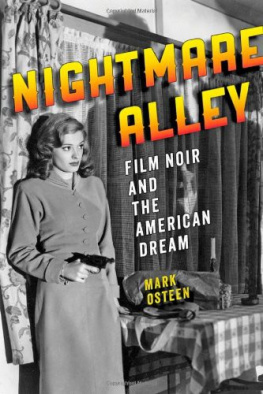I am grateful to Hannah Patterson for her faith in this project from the beginning and for all her wonderful advice on the way to its completion. Linda Halisky, David Kann, Steven Marx and Kathryn Rummell helped provide me with a sabbatical along with travel and research funds which proved vital to sustaining this work. I am lucky to have benefited from stimulating conversations about film with Damon Bailey, Cameron Bowman, Kevin Clark, Jack Conroy, George Cotkin, Bill Covey, Michael Flores, William Frederick, David Gillette, John Hampsey, John Harrington, Brenda Helmbrecht, Scott Keesey, Carol MacCurdy, Andy Maness, Paul Marchbanks, Cheryl Ney, Tom OBrien, Todd Pierce, Johanna Rubba, Mark Stablein, Glen Starkey and Patricia Troxel. My special thanks to Jim Dee for screening neo-noirs for my film students at the Palm Theater. I owe a huge debt of gratitude to Cal Polys marvellous support staff; their prompt, professional and patient help has made all the difference to me: Katie Tool, Connie Davis, Sue Otto, Kathy Severn and Margie Valine in the administrative offices; Karen Beaton, Judy Drake, Linda Hauck, Jan Kline, Nancy Loe, Heather Lucio, Jos Montelongo, Holly Richmond, and Janice Stone in the library; Daniel Barnicle, Tom Dresel, Jennifer Hodges, Daniel Park and Velanche Stewart of the CLA Tech Team. My parents, Donald and Phyllis Keesey, continue to be an inspiration to me in so many ways. Finally, I am grateful to my wife, Helen Bailey, without whose company I would never have ventured to go down these mean streets.
Im a bad girl, says Laure (Rebecca Romijn) in Femme Fatale, real bad rotten to the heart. Laure knows that shes a femme fatale. In fact, she just watched Double Indemnity on TV and is modelling her behaviour after that of the lovely but lethal Barbara Stanwyck in that film. In Basic Instinct, writer Catherine Tramell (Sharon Stone) tells detective Nick Curran (Michael Douglas) that her book is about a detective. He falls for the wrong woman. She kills him. They both know that this is the plot of many classic film noirs and we know that they know and are intrigued to discover whether their story will turn out the same. This isnt going to have a happy ending, Somerset (Morgan Freeman) tells Mills (Brad Pitt) in Se7en, for Somerset is conscious of the role they are playing in the kind of noirish tale that almost always has a dark conclusion. (Film noir is French for dark movie with dark meaning sinister and dreadful as well as shadowy, as in Raymond Chandlers great line, The streets were dark with something more than night.) Contemporary film noir, or neo-noir, is a highly self-conscious genre, keenly aware of the plot conventions, character types and common techniques associated with past film noirs. Indeed, some neo-noirs are actually about scripting or acting in noir films (The Singing Detective, Bad Education, INLAND EMPIRE), while other neo-noirs are remakes of classic film noirs (The Postman Always Rings Twice) or retro-noir homages set in the period of, and consciously styled after, past noir films (Chinatown, Body Heat, L.A. Confidential, The Man Who Wasnt There).
The time span of classic film noir is often said to stretch from The Maltese Falcon (1941) to Touch of Evil (1958). Although they had some growing awareness of genre conventions, the makers of the great 1940s and 50s noir movies Double Indemnity, Laura, Detour, The Postman Always Rings Twice, D.O.A., Sunset Blvd., Kiss Me Deadly, The Killing and Vertigo did not conceive of them as a single genre of film noirs. Instead, these movies were known by a variety of different labels, including crime stories, suspense pictures, psychological thrillers and melodramas. It was French critics, particularly Raymond Borde and Etienne Chaumeton in their 1955 book A Panorama of American Film Noir, who first popularised the term film noir, noting that several of these movies were based on the hardboiled detective fiction and crime novels of Raymond Chandler, Dashiell Hammett and James M Cain, which had been published in France under the imprint Srie Noire (meaning a dark series of books but also punning on a series of bad events). As the study of this newly recognised genre took off among British and American critics in the 1970s, the roots of film noir were traced to German Expressionist, French Poetic Realist, and Hollywood gangster films of the 1920s and 30s. In addition to these cinematic precursors, the biggest historical influences were identified as World War II and the ensuing Cold War, with the violence of combat, the threat of nuclear destruction and the red scares of McCarthyism spreading paranoia, rage and disillusionment all emotions characteristic of film noir. The femme fatale seducer and betrayer of the hapless hero was also seen as springing from a post-war change in the balance of power between the sexes: male veterans, physically and psychically wounded in the war, came home to find that women had grown in financial and sexual independence from having joined the workforce as part of the home-front war effort. Men found such powerful women both alluring and frightening the same ambivalence felt for the femme fatale. Techniques that have been identified as typical of film noir include dark shadows, particularly those that fall in chiaroscuro patterns like bars or spiders webs, seeming to entrap the hero; oppressive, angle-down shots and claustrophobic framings; distorting mirrors and unbalanced compositions; and flashbacks and voiceover narration that give visual and aural emphasis to the personal traumas experienced by the disoriented and doomed hero.
And yet, despite the many efforts to describe it, film noir remains the most disputed of all movie genres. Critics disagree about whether there is any one defining element common to all film noirs and about which movies fit and which should be excluded from the genre. As James Naremore points out, There are many themes, moods, characters, locales, and stylistic features associated with noir, no one of which is shared by all the films that have been placed in the category.
Which brings us to neo-noir. If defining classic film noir is difficult, the challenge only increases with contemporary film noir. Since, as Mark Bould rightly observes, each additional film noir rethinks, reconstructs and refabricates the genre, in addition to being highly self-conscious of their relation to past noirs, neo-noirs are characterised by blurred boundaries and hybrid genres, and that what is new about neo-noirs can be traced to the influence of contemporary social changes and historical events as well as the latest trends and technological advances in filmmaking.
Blurred Boundaries
Many classic film noirs consist of three character types: the investigator, the villain and the victim. While even past noirs put some pressure on the boundaries between these types, neo-noir really tends to erode these distinctions. In The French Connection, Popeye Doyle (Gene Hackman) is a zealous cop whose reckless disregard for the law may help him to catch crooks but also threatens to make him one of them, as this film points to the thin line between the policeman and the criminal which is very often crossed over. the stereotype to become investigator-heroes (as in Femme Fatale and INLAND EMPIRE), but female investigators can also be morally compromised to the point of villainy (see Blue Steel and demonlover). Finally, male investigators are more likely to end up as victims in neo-noir, not only because the villains are too strong for them but because the investigators themselves are morally compromised so complicit that they have already lost part of the battle. Even in classic film noir, the detective was often beaten up and tempted by sin on the way to solving the case and catching the killer, but the investigations in neo-noir can end in pyrrhic victory or outright failure, with the hero himself becoming just another victim (see










